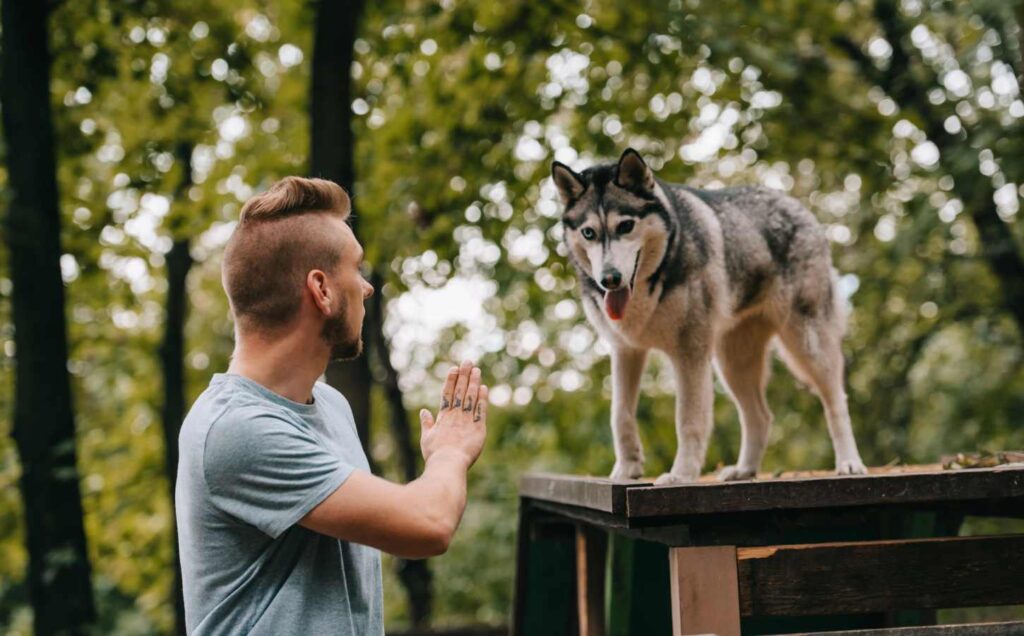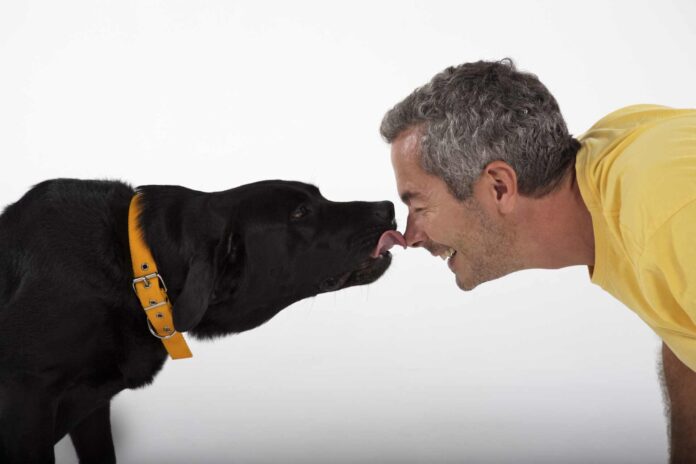Many dog owners encounter myths that shape their understanding of canine behavior.
These misconceptions can lead to confusion and miscommunication between dogs and their humans. By addressing these common beliefs, it becomes possible to foster a better relationship between dogs and their owners, ensuring that both understand each other more clearly.
Some of these myths can result in ineffective training methods or unnecessary stress for dogs. Understanding the truth behind these misconceptions allows owners to approach their pet’s behavior with knowledge and compassion. In this article will be debunking 7 common dog behavior myths, revealing what’s really going on in the canine world.
Whether it’s the belief that dogs feel guilt or the assumption that a wagging tail means happiness, separating fact from fiction is essential. This exploration not only clarifies behaviors but also highlights the complexities of dog emotions and instincts. Ultimately, owners will gain insights that can positively impact their interactions with their pets.
Understanding Canine Behavior
Canine behavior is influenced by a combination of body language, communication techniques, breed characteristics, and emotional states. Recognizing these elements can foster a better relationship between dogs and their owners.
Decoding Dog Body Language
Dog body language is crucial for understanding how a dog feels in different situations. Key indicators include tail position, ear orientation, and posture. A wagging tail, for instance, can signify excitement, but the speed and height can convey varying emotions.
- Relaxed dogs: A low, wagging tail indicates comfort.
- Anxious dogs: A tucked tail or a stiff posture suggests fear.
Understanding these nuances allows owners to respond appropriately to their dog’s needs. Observing body language helps identify when a dog is relaxed, playful, or distressed.
Communication Beyond Wagging Tails
While tail wagging is a common form of communication, it does not tell the whole story. Dogs also use vocalizations, facial expressions, and proximity to communicate.
- Vocalizations: Barking, whining, and growling each serve different purposes.
- Facial expressions: A relaxed face indicates comfort, while bared teeth may signify stress.
Dogs approach other dogs and humans differently based on their comfort levels, which underscores the importance of understanding these signals for effective interaction.
The Role of Breed in Behavior
Breed plays a significant role in shaping dog behavior. Different breeds have varying temperaments, energy levels, and innate traits. For instance, herding breeds like Border Collies often display high energy and intelligence, while breeds like Bulldogs may be more laid-back.
Owners should research their dog’s breed to better understand its tendencies and needs. This knowledge can assist in training, exercise requirements, and socialization efforts. Tailoring care and activities to a specific breed’s strengths and weaknesses can enhance the dog’s wellbeing.
Stress and Anxiety Signals
Recognizing stress and anxiety signals in dogs is critical for their welfare. Common signs include excessive barking, chewing, or pacing.
- Body posture: An anxious dog may have a tense body, lowered head, or frantic tail movements.
- Vocalizations: Increased barking or whining can also indicate discomfort.
Addressing these signs promptly can mitigate stress and improve a dog’s quality of life. Owners may need to implement calming techniques or consult with a veterinarian to develop effective management plans.
Myths of Dominance and Submission
The beliefs surrounding dominance and submission in dogs often stem from outdated interpretations of canine behavior. Understanding the realities is crucial for fostering a positive human-dog relationship.
Alpha Dogs: Reality or Myth?
The concept of the “alpha dog” is commonly misunderstood. In the wild, wolf packs do not operate solely on a strict hierarchy with an alpha male and female at the top. Instead, they function more like family groups where individuals cooperate for survival.
Studies show that domesticated dogs are more influenced by their relationships than by dominance hierarchies. Behavior is often a reflection of training, socialization, and environmental factors rather than the quest for status.
Recognizing that dogs are social animals helps clarify their behaviors. They value connections and trust more than enforcing dominance.
Respecting the Pack Hierarchy
Respect in dog behavior doesn’t always equate to a dominance model. Instead of establishing control, owners should focus on building a collaborative relationship based on trust and positive reinforcement.
Pack dynamics among dogs can involve various roles rather than strict hierarchies. Individual personalities and experiences shape their interactions.
Promoting mutual respect leads to healthier relationships and more cooperative behaviors.
Socialization and Play Behaviors
Socialization and play are crucial for a dog’s development, impacting their behavior and interactions with others. Understanding these aspects helps owners create a positive environment for their pets.
The Importance of Early Socialization
Early socialization is vital for puppies, as it shapes their behavior and temperament. Exposing them to various environments, people, and other animals helps prevent fear and aggression later in life.
Socialization should begin between 3 to 14 weeks of age. This is when dogs are most receptive to new experiences. Dog parks offer great opportunities for controlled social interactions. Engaging with canine companions during this period builds confidence and reduces the likelihood of behavioral issues.
Lack of proper socialization can lead to anxiety and fear-based behaviors. This might manifest in excessive barking, aggression, or avoidance. Therefore, consistent exposure to different stimuli is essential for a well-adjusted adult dog.
Understanding Play and Excitement
Play is an essential aspect of a dog’s life, serving as a form of communication and a way to expend energy. Dogs engage in play to practice social skills and establish their boundaries with other dogs.
During play, dogs exhibit excitement through various behaviors like barking, chasing, and pouncing. Understanding these actions can help owners recognize when it’s a playful interaction versus a potential fight.
Interactions at a dog park can vary widely. Some dogs may display more dominant behaviors, while others prefer to take a backseat. Play yields numerous benefits, including physical exercise, mental stimulation, and bonding with owners or other dogs.
Maintaining a well-balanced play routine is crucial. It addresses natural instincts and offers a productive outlet for their energy, leading to a more harmonious home environment.
Training and Reinforcement Strategies
Effective dog training hinges on strategic approaches that foster learning and good behavior. Key methods include positive reinforcement and maintaining consistency, both of which significantly impact a dog’s response to training.
Positive Reinforcement in Dog Training
Positive reinforcement involves rewarding desired behaviors to encourage their repetition. This approach can include treats, praise, or toys. For instance, when a dog sits on command, giving a treat immediately reinforces that behavior.
Key benefits of positive reinforcement:
- Builds trust between the dog and trainer
- Increases motivation and willingness to learn
- Reduces fear-based responses, making training more enjoyable
Incorporating a variety of rewards can keep the dog engaged. A dog trainer might suggest using high-value treats for more difficult tasks while using everyday treats for well-known commands. This tactic promotes effective learning and strengthens the bond between the dog and its owner.
Consistency in Commands and Routine
Consistency is crucial in dog training. Using the same commands and gestures for specific behaviors helps the dog understand what is expected. For example, using “sit” every time a dog is asked to sit establishes clear communication.
Establishing a routine can enhance a dog’s learning process. A daily training schedule that includes short sessions helps reinforce commands and behaviors.
Tips for maintaining consistency:
- Use the same vocabulary and tone with each command
- Ensure all family members use the same training methods
- Regularly practice commands in various settings to generalize learning
When training is consistent and routine, dogs are more likely to exhibit desired behaviors and respond swiftly to commands.
Dealing with Aggression and Fear
Dogs can exhibit aggression and fear for various reasons. Understanding these behaviors is crucial for effective management and fostering a safe environment.
Responding to Aggressive Behavior
Recognizing the signs of aggression in dogs is vital for safety. Common indicators include growling, snapping, baring teeth, or rigid body posture. Understanding body language can prevent escalation.
When faced with aggression, owners should stay calm. Avoid direct eye contact, which can be perceived as a challenge. Instead, use a firm but gentle voice to command attention.
It’s essential not to yell or punish the dog. This can worsen aggression or instill fear. Instead, redirect the dog’s focus to a positive stimulus, such as a toy or treat. Consistent training can also help reduce aggressive tendencies over time.
Understanding Fear in Dogs
Fear in dogs may arise from previous trauma, lack of socialization, or unfamiliar environments. Recognizing fear-related body language, such as cowering, tail tucking, or excessive yawning, is important.
Owners should create a safe space where the dog feels secure. Gradually introducing the dog to fear-inducing stimuli can help desensitize them. This process often involves rewarding calm behavior to reinforce positivity.
Using techniques such as counter-conditioning can shift the dog’s emotional response. Providing a calm environment and patience are key. Fearful behaviors may take time to address effectively, but consistent, nurturing efforts can lead to significant improvements.
Health and Maintenance Misconceptions
Many dog owners hold misconceptions about their pets’ health related to dental care and the concept of “dog years.” Understanding the facts can lead to better health choices for dogs.
Dental Hygiene and Dog Health
Dental hygiene is crucial for a dog’s overall health. Neglecting it can lead to periodontal disease, which affects not just the mouth but also can lead to systemic issues like heart and kidney disease.
Key aspects include:
- Bacteria Build-Up: Plaque forms when bacteria accumulate on teeth. Regular brushing can prevent this.
- Size Matters: Smaller breeds often face dental problems more frequently than larger breeds, redefining needs for dental care.
It’s important for owners to consult veterinarians about proper dental hygiene practices, including professional cleanings and suitable chew toys.
The Truth About ‘Dog Years’
The concept of “dog years,” while catchy, can mislead dog owners regarding their pet’s health status. The common belief that one dog year equals seven human years oversimplifies the aging process.
Consider the following:
- Age Factors: Dogs age differently based on breed and size. Larger dogs tend to age faster than smaller ones.
- Health Implications: A dog’s developmental stages vary, with significant milestones occurring in the first few years.
Understanding this complexity helps owners provide age-appropriate care and nutrition as their dogs age, enhancing quality of life.
Debunked: ‘Old Dogs Can’t Learn New Tricks’
The myth that old dogs can’t learn new tricks is prevalent but inaccurate. Science shows that dogs of all ages can learn, albeit in different ways.
Key Factors Influencing Learning in Older Dogs:
- Cognitive Health: Just like humans, a dog’s ability to learn may vary based on cognitive health. Some breeds are known for their longevity and mental sharpness.
- Motivation: Older dogs often have different motivations. Treats, praise, and play can be highly effective in encouraging learning.
- Experience: Older dogs bring life experience to training. They may pick up commands and routines more quickly because of familiarity.
Learning Methods:
- Positive Reinforcement: This method remains effective across ages. Rewarding good behavior helps reinforce learning.
- Short Sessions: Older dogs may benefit from shorter, more frequent training sessions. This approach prevents frustration and maintains their focus.
- Consistency: Clear commands and consistent reinforcement can help older dogs understand expectations.
Important Considerations:
- Individual differences matter. Some breeds, like Border Collies or Poodles, may continue to excel in learning throughout their lives.
- Age-related changes, such as reduced hearing or vision, can impact how an older dog learns. Adjusting training techniques can help accommodate these changes.
In essence, old dogs can indeed learn new tricks, provided their training is tailored to their unique needs and abilities.
Frequently Asked Questions: Debunking 7 Common Dog Behavior Myths
Many individuals hold misconceptions about dog behavior that can lead to misunderstandings in training and care. It is essential to clarify these points and provide a factual basis for recognizing and interpreting dog behaviors.
What are some common misconceptions about dog behavior?
Common misconceptions include the belief that dogs feel guilt or that they thrive on dominance hierarchies. Additionally, some people think dogs naturally understand human emotions and will always behave accordingly. These ideas often reflect anthropomorphism rather than grounded behavioral science.
How can one distinguish between normal and abnormal behaviors in dogs?
Normal behaviors include barking, chewing, and digging, while abnormal behaviors may involve excessive aggression, withdrawal, or compulsive actions. Observing the context and frequency of these behaviors can help in determining their appropriateness. If a behavior disrupts daily life or poses risks, it may signal a need for intervention.
What are the scientific explanations behind typical dog behaviors?
Behaviors such as wagging tails, eager greetings, and playfulness can often be explained through evolutionary adaptations. These actions serve communication purposes and strengthen social bonds. Research also shows that certain behaviors are linked to breed characteristics and the dog’s environment.
Are there behaviors that indicate psychological issues in dogs?
Yes, signs of psychological issues can manifest as aggression, excessive barking, or avoidance behavior. Changes in appetite or energy levels may also indicate distress. Behavioral changes emerging after a traumatic event should prompt consultation with a professional.
How can you accurately identify if a dog recognizes its misbehavior?
A dog may show signs of recognition by displaying submissive postures, avoiding eye contact, or exhibiting appeasement behaviors after a correction. Not all dogs will display these cues, and their understanding can vary significantly between individuals. It is crucial to observe these behaviors in context rather than assuming guilt.
What methods are effective in correcting undesirable dog behaviors?
Positive reinforcement training tends to be the most effective for correcting undesired behaviors. This method encourages desired actions through rewards, rather than punishing bad behavior. Strategies include redirecting attention, providing alternative behaviors, and consistency in commands and expectations.
Understanding and Managing Behavioral Issues in Young Dogs

Learn how to identify and address early signs of behavioral issues, common problems in young dogs, their causes, effective training techniques, the role of exercise and environment, seeking professional help, and the importance of proactive management.
Continue reading here: Understanding and Managing Behavioral Issues in Young Dogs
How to Train a Dog That is Not Food Motivated: Tips and Techniques

While food is a commonly used motivator in dog training, it’s important to remember that not all dogs are food motivated. Some dogs may prefer toys, praise, or other rewards instead. To identify what motivates your dog, it’s important to observe their behavior and preferences.
Continue reading: How to Train a Dog That is Not Food Motivated




